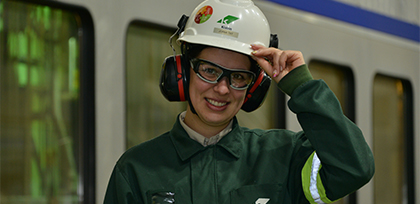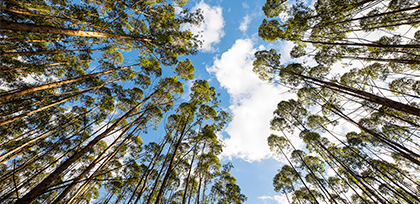The information obtained from the SAR (Synthetic Aperture Radar) system was processed using an image-oriented deep learning technique, resulting in an anthill detection rate of 80% with no false alarms.
Forest development
Forest development
Klabin's growth strategy is directly connected to research and development initiatives to enhance the productivity of its forests. Interactions between the factors that exist in the environment (such as soil, water, animal and plant species, and temperature) are always evaluated for the management of pine and eucalyptus forests, aiming to maximize the productive gains of each species in the regions where Klabin operates and in all ongoing forest expansion projects.
the branch of comparative physiology that studies the physiological diversity in relation to the environment and its impact on the ecology of organisms.
GlossárioThe assessment of the wood to be purchased and its effect on the final quality of the pulp are also within the purview of Klabin's R&D department.
Technology for monitoring anthills
The pilot project for monitoring ant hills using embedded radars on drones has the unique ability to accurately identify underground colonies, expanding and strengthening monitoring and control efforts of leaf-cutting ants in planted forests. The monitoring of leafcutter ants is an ongoing activity in planted forests, as the insect has a high potential to cause damage, potentially reducing crop yields productivity by over 15% if not managed. The project was developed in collaboration with Radaz, an expert in Remote Sensing Radar, and Universidade Estadual de Campinas (Unicamp).
Eucalyptus seedlings, in Santa Catarina. Photo: Anna Carolina Negri.
From the forest to the forest
The use of potassium sulfate in forest fertilization is another example of Klabin's extensive research. The installation of a plant for the production of this chemical compound at the Puma Unit (PR), from the recovery of potassium (an element present in wood and not used in the industrial process) extracted from the ashes generated in the recovery boiler and was preceded by a research effort that included chemical analysis, technical review, tests, definition of an operational model, and other processes, leading to the recommendation of its use in the forestry sector as a substitute for potassium chloride.
an economy that keeps materials and products in circulation for as long as possible. The goal of the circular economy is to reduce waste by optimizing the design of materials, products, processes, and business models, utilizing materials that are recyclable, recycled, compostable, and/or biodegradable.
Glossário
Learn more at:
Precision forestry
set of practices that use data collected in the field to promote the management of the plantation in a more efficient and assertive manner. The technologies provide a more comprehensive view of the production system, enabling the optimization of inputs, which in turn contributes to increased productivity and reduced environmental impacts.
GlossárioThe primary challenge for the Forestry Unit is to utilize applied science – such as precision forestry – to gain both in terms of forest growth and cost savings when expanding the forest base.
Productivity that comes from research
Since it began planting eucalyptus forests with market clones in its operations, Klabin has been continuously improving the development of clonal materials. Every two years, the Company releases new clones to be incorporated into its planting program, which has had a significant impact on boosting the productivity of the company's forests. The developed clones show 20% more productivity, when compared to the operational market clones planted previously.
A similar evolution is seen in the plantations of the mountainous region of Santa Catarina, where the company's R&D has had a strong impact on the development of frost-tolerant clones, which now have yields above the national average for eucalyptus. The productivity evolution in this case was 19% since the beginning of the project in 2007. In addition to being more productive, these clones have greater resistance to pests and diseases, as well as higher fiber yields at Klabin's factories.
Currently, Klabin has eight clones protected in Paraná and six in Santa Catarina. Another eight clones, which are in the semi-operational phase, will be registered and protected by the Ministry of Agriculture, Livestock and Supply soon.
It is no different for the pine genus. By selecting new sources and utilizing genetic improvement through the selection of superior families, it is possible to increase productivity in pine forests by up to 12%. In order to achieve this gain, Klabin began commercially planting the new materials, produced through vegetative propagation, on 1,000 hectares in 2022.
The development of genetic materials of pine through vegetative propagation has also been gaining prominence. In 2022, seedlings with new genetic materials, which increase forest productivity by 10-12%, were planted across one thousand hectares of forest areas, the largest area planted with these materials to date by Klabin.











